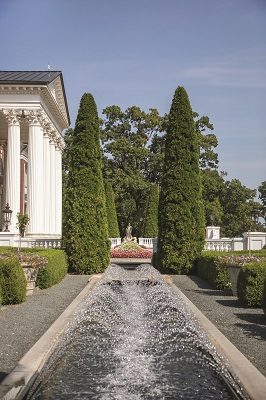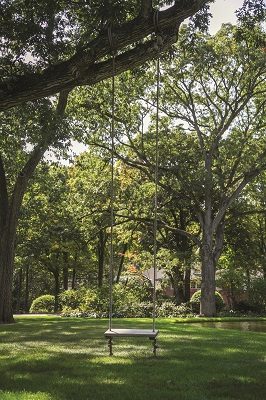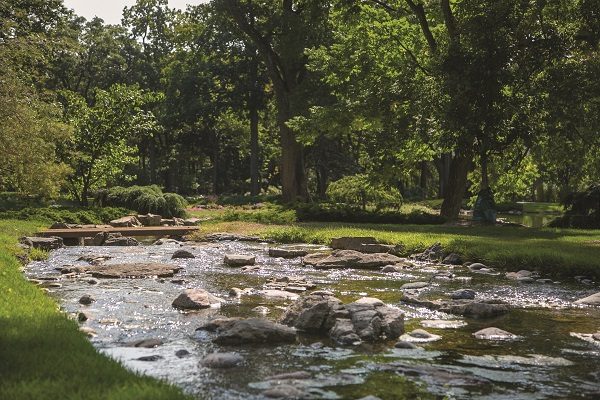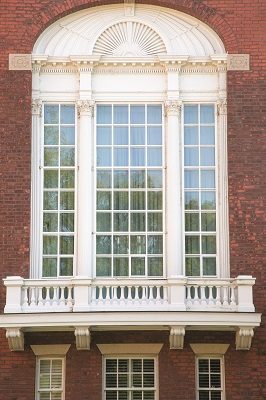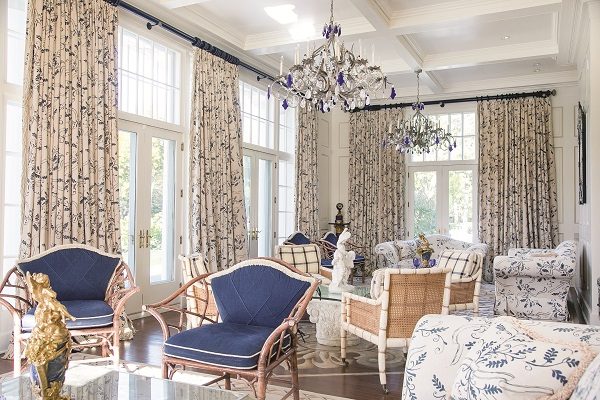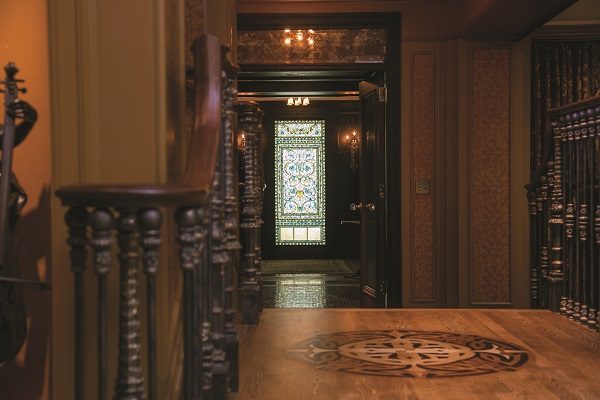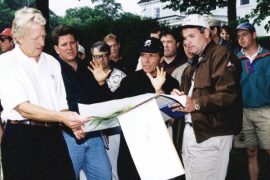By Anne Morrissy | Photography by Shanna Wolf
Editor’s note: In March of 2021, we mourned the passing of Richard H. Driehaus, the subject of this article, whose passion for historic preservation and civic beautification enriched Lake Geneva for more than 20 years. Following his death, his Geneva Lake estate, Glanworth Gardens, was sold to new owners for $36 million, the highest real estate sale in Wisconsin history.
The first time Chicago philanthropist Richard H. Driehaus came to Lake Geneva, he was a college student at DePaul University in Chicago. A member of the Tau Sigma fraternity at the time, he came up one summer for a short trip with a group of his fraternity brothers, and they took a boat ride from the Riviera Docks along the north shore of the lake. His strongest memory of the trip is staring in awe at the opulent estates lining the shore. “I was so amazed at these buildings,” he remembered, “and I was wondering if we could walk on the grounds.” He had no way of knowing at the time that more than 30 years later, he would purchase possibly the grandest of those historic Geneva Lake estates — the one that was first known as Wadsworth Hall.
He also might never have guessed that he would eventually celebrate every birthday here, with a Gatsby-esque extravaganza featuring celebrity entertainment and a different theme each year. Staring at the Lake Geneva shoreline with his fraternity brothers that day in the 1960s, it is unlikely he sensed that on his 65th birthday, for example, he would enter the party riding high atop an elephant and dressed in a custom-made ringmaster’s suit. Along the journey between DePaul and the Driehaus Circus, Richard Driehaus discovered deep passions for classical architecture and historic preservation, interests which have greatly affected the estate now known as Glanworth Gardens, and passions which continue to enrich the Lake Geneva area in countless ways today.
WADSWORTH HALL
The estate that Driehaus renamed in honor of his mother’s birthplace in Glanworth, County Cork, Ireland, has been hosting elegant parties since it was first completed in 1906. Norman Wait Harris, founder of Harris Trust and Savings Bank, and his wife Emma Gale Harris commissioned the Georgian Revival mansion from noted Boston architectural firm Shepley, Rutan and Coolidge, who had designed a number of important civic projects in Chicago — including the Art Institute of Chicago, the Chicago Public Library (now the Chicago Cultural Center) and more than 15 buildings on the University of Chicago campus — and were popular with the city’s elite as a result. (The firm also designed Wychwood for the Hutchinsons on Geneva Lake.)
Even by opulent Gilded Age standards, the home the Harrises commissioned as a Lake Geneva summer residence was breathtaking. Sited on nearly 40 acres of land with 800 feet of lake frontage, the main house contained 13 bedrooms, a grand entry hall featuring 40-foot ceilings, a wood-paneled library, an elegant terrace, and a formal dining room ornamented intricately with piping, garlands and leaves on the ceiling. The Harrises named it Wadsworth Hall, reportedly after Henry Wadsworth Longfellow, a distant relative. The total cost to build the home in 1906 was around $250,000, or more than $6 million in today’s money.
NORMAN WAIT HARRIS
Norman Wait Harris was born in 1846 in Massachusetts and attended the Westfield Academy. After graduation, he entered the insurance business, eventually founding the Union Central Life Insurance Company in Ohio, the second largest insurance company in the United States at the time. Unfortunately, the rapid success of his company and the death of both his first and second wives during this time took a toll on Harris’ health, and he ultimately stepped down from the company to travel and recuperate.
Returning from Europe, Harris married Emma and settled in Chicago. They would go on to have three children together. In 1882, he founded a banking firm under his own name: NW Harris & Co., later changing the name to Harris Trust and Savings Bank (which eventually merged with the Bank of Montreal to form BMO Harris Bank.) In addition to his vast business success, Harris was a well-respected philanthropist, supporting the YMCA, the Methodist Church, Wesley Memorial Hospital, Northwestern University, and, famously, the Field Museum, where a sizable donation established the Harris Public School Extension program (now the NW Harris Learning Collection at the Field Museum.)
THE STENNING
Harris only enjoyed 10 summers at Wadsworth Hall; while traveling in Japan in 1916, he suffered a non-fatal heart attack. Returning by ship and then by train, he arrived in Lake Geneva for the season, but sadly passed away from heart-related complications in July. Emma died just three years later, leaving the property to their daughter Pearl and her husband, who had been married in the house in 1910. (The Chicago Tribune carried a detailed description of the wedding.) Despite their happy memories there, Pearl and her husband chose to sell the property in 1920 to Walden W. Shaw, co-founder of the Yellow Cab Company in Chicago. Shaw renamed the estate The Stenning, after his grandfather’s home in England.
Shaw’s daughter, Bessie K. Shaw, married Daniel Peterkin Jr., a Morton Salt executive. Walden Shaw began spending more and more time at his home in California, so following their wedding in 1929 Bessie and Daniel Peterkin moved into The Stenning, an ownership that would last more than six decades. Bessie passed away in 1959; Daniel Peterkin remarried and ultimately willed the home to his second wife, Dorothy. Very few changes were made to the home throughout this extended length of time, and Peterkin struggled in later years to keep up with the significant maintenance required by such a large and historic home.
RESCUING THE PAST
When Dorothy Peterkin passed away in 1997, the house went up for sale for the first time in nearly 80 years. And Richard Driehaus, now the Founder and Chairman of Driehaus Capital Management, was looking for a summer getaway he could enjoy with his family. Through a friend, he learned that the former Harris estate was available, so in the summer of 1998, he arranged for a tour.
“I went in the house and I saw this big, grand room, which would have been the entrance hall,” he said. “Then I took a right into the library and I saw all that beautiful cross-sawn oak… Then I went into the dining room and saw the ceilings. And that’s when I said, ‘This could be it.’”
Driehaus was undaunted by the condition of the home, which was suffering from decades of deferred maintenance. Having recently purchased and restored the former Cable House in Chicago’s River North neighborhood to use as an office space, Driehaus was ripe for a new project that combined his love of classical architecture and historic preservation. “I needed at this time in my life another challenge, in a way. I wanted to make some impact, and of course I also like preservation. This is all really about preservation.”
He estimates he bought the estate for around $5 million in August of 1998, and then set a goal of finishing the significant restorations in time to host a grand New Year’s Eve party there to ring in the new millennium. The restorations proved to be a massive undertaking. In order to make the deadline, as many as 100 laborers were working in the house at once, seven days a week.
When necessary, Driehaus himself would fly from Chicago by helicopter to make final decisions or weigh in on challenges that arose. For example, the ornate plaster ceiling in the dining room had begun to detach, so a new method had to be devised to retighten and re-set the plasterwork.
Nearly every aspect of the home needed to be addressed in some way: the electricity, heating and cooling, plumbing and security were all updated to modern standards of efficiency and sustainability, while the exterior, the interior finishes and the grounds needed substantial restoration work. “The biggest challenge was controlling costs,” Driehaus said. “It turned out to be a very expensive project.” But on New Year’s Eve 1999, the hard work paid off, and the newly preserved estate hosted the first of what would turn out to be many epic parties.
KEEPING LAKE GENEVA BEAUTIFUL
For two decades, Richard Driehaus’ summer birthday parties were the stuff of local legend. A theme was chosen, a substantial guest list was drawn up, invitations (some of them award- winning) were sent out, a high-profile performer was invited and no expense was spared. No two birthday parties were ever the same, but the evening always culminated in a spectacular fireworks display, equally appreciated by party-goers, and the significant number of area tourists and local spectators who gathered around the estate in boats, eager for the show.
When askeTwo of his favorite party themes were the Wizard of Oz theme and the Drive-In theme, which allowed him to highlight his substantial classic car collection. (Fellow vintage car enthusiast and comedian Jay Leno provided the entertainment.) “The parties are really just about enjoying life,” Driehaus said. They were also a tourism generator, helping fill the area’s hotels as people planned their vacation around the annual fireworks display.
Additionally, since purchasing Glanworth Gardens, Driehaus became actively involved with preservation and beautification in the city of Lake Geneva. He is the founder and former chairman of the Lake Geneva Beautification committee, which since 2004 has sponsored many local improvement projects. The committee has been the driving force behind the installation of sculpture and signage welcoming people to the city. They have added fountains in front of the Geneva Lake Museum and the Lake Geneva Utility Commission building and restored the plaza in front of the Riviera (now named the Driehaus Family Plaza), among many other achievements.
According to Carol Wyant, who served as Driehaus’ representative on the Beautification Committee, each year the group plants tulips in high-traffic areas in the city of Lake Geneva and encourages businesses and homeowners to put extra effort into landscaping and holiday decorations through a beautification recognition program. The committee also upgraded and unified the lighting in the Driehaus Family Plaza and adjacent areas of the Riviera. “Wherever Richard had a home, he made it a practice to provide a lot of support to that community,” she explained.
PRESERVING THE PAST TO ENJOY IN THE FUTURE
Even once he considered the house “essentially complete,” Driehaus maintained that the grounds and gardens were a constant work in progress. The original landscaping plans were drawn up by the famous Olmsted Brothers landscape architecture firm, but never fully executed. After purchasing the estate, Driehaus worked with Terry Guen Associates of Chicago to revive the Olmsteds’ vision and add new elements. He planted more than 100 new trees and began a landscaping plan to simplify and open up the garden areas behind the house. Other projects included the reconfiguration of the lengthy entry drive, the addition of a swimming pool, the revival of a walled garden (or potager) and the addition of a charming “children’s village” for imaginative play.
The overall effect — from the grounds to the interior and exterior renovations to the priceless private collection of antiques on display — is exquisite, and truly unparalleled. When asked what most inspired him about Glanworth Gardens, Driehaus said he has always been interested in sense of place. “There are four elements to that,” he explains. “Scale, form, quality of materials and individual characteristics that are absolutely unique.” Then he went on to quote the French philosopher Ernest Dimnet from memory: “Architecture, of all the arts, is the one which acts the most slowly, but the most surely, on the soul.” It is a sentiment that speaks to architecture’s long-reaching effects. In the case of Glanworth Gardens, Richard Driehaus first experienced these effects on that fateful Tau Sigma boat ride and they resonated for him for decades.
Listening to Driehaus speak about his love of historic preservation, it became clear that he was inspired to leave pieces of history for future generations to appreciate, combining an appreciation for the past with a hope for the future. It’s an outlook that was echoed in his approach to the annual birthday parties as well. “The next one is always going to be the best one,” he said, smiling.



